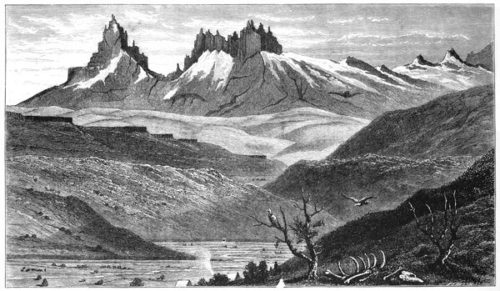Sierra Baguales is about an hour and a half from Awasi Patagonia, and sits right on the border with Argentina. It takes its name from the Spanish word ‘bagual’, meaning a wild or feral horse or cow. The area was christened Baguales by early settlers as they found a large number of wild horses living there. Florence Dixie also passed through the area on her Patagonian expedition as in her book she makes reference to a ‘wild horse glen’ which is accompanied by an illustration that looks very similar to the current profile of the mountain range.

‘Wild horse glen’ – illustration from Florence Dixie’s ‘Across Patagonia’
George Chaworth Musters also described the valley in his book “At Home with the Patagonians” (1873):
“The valley of the Rio Gallegos, where the very remarkable bench formation, afterwards observed on a smaller or larger scale in other Patagonian rivers, first arrested my attention. To the west, some miles away, a high hill, apparently of basalt, the square summit of which with seemingly regular walls and towers mimicked the distant view of an extensive fortress. Looking up towards the Cordillera from our encampment, the valley appeared to expand a few miles up into one immense plain, and the Indians informed me that before reaching the mountains there is a great drop or basin where the wild horses are found.”
Nowadays the area still remains fairly wild, although any horses that you might see there most likely belong to one of the neighbouring estancias. There is, however, apparently a wild bull which was left there one winter and has never been retrieved!

One thing is that very interesting about Baguales is the behavior of the wildlife. For example the guanacos, which inhabit this landscape are completely wild, unlike in Torres del Paine National Park where they are accustomed to the presence of people. This is truly untouched Patagonia.
The peaks that make up the range are very beautiful and take their names from architecture, such a Catedral (cathedral) and Ciutadella (citadel). The rock formations hint at a Middle Eastern Temple – quite amazing to think that they are the result of naturally occurring events and not carved by hand!
Trekking through the Sierra Baguales takes you up to an area full of fossilised leaves, where every third stone that you turn over has the imprint of a leaf on the underside. The leaves fell from trees over 20 million years ago, which is such a long time ago that I find it hard to comprehend. What is more, the fossilised leaves are from ‘lenga’ which is a type of oak (latin name: nothofagus pumilio) that is still found within the park.

From there you climb up quite a steep slope to a look out point, with a view out over a snow covered valley and a frozen river below. Once the snow melts it is possible to find fossilised sharks teeth and tree trunks.
You then walk down into a valley and climb up to a huge ridge of intrusive igneous rock. This means that millions of years ago magma from the earth’s mantel forced its way up into the earths crust, cooling slowly below the surface, resulting in the formation of larger, more erosion resistant rock crystals. Over time glaciers and the effects of the elements have worn away the sedimentary rock that surrounded the igneous intrusion, forming a crest or dyke which runs along the length of the top of the valley. The formations are again very beautiful, and resemble a piece of modern sculpture.
For guests staying at Awasi, Sierra Baguales is one of the exclusive outings that we offer as part of our list of private excursions.

